AUDI A6 2012 Owners Manual
Manufacturer: AUDI, Model Year: 2012, Model line: A6, Model: AUDI A6 2012Pages: 298, PDF Size: 74.43 MB
Page 141 of 298
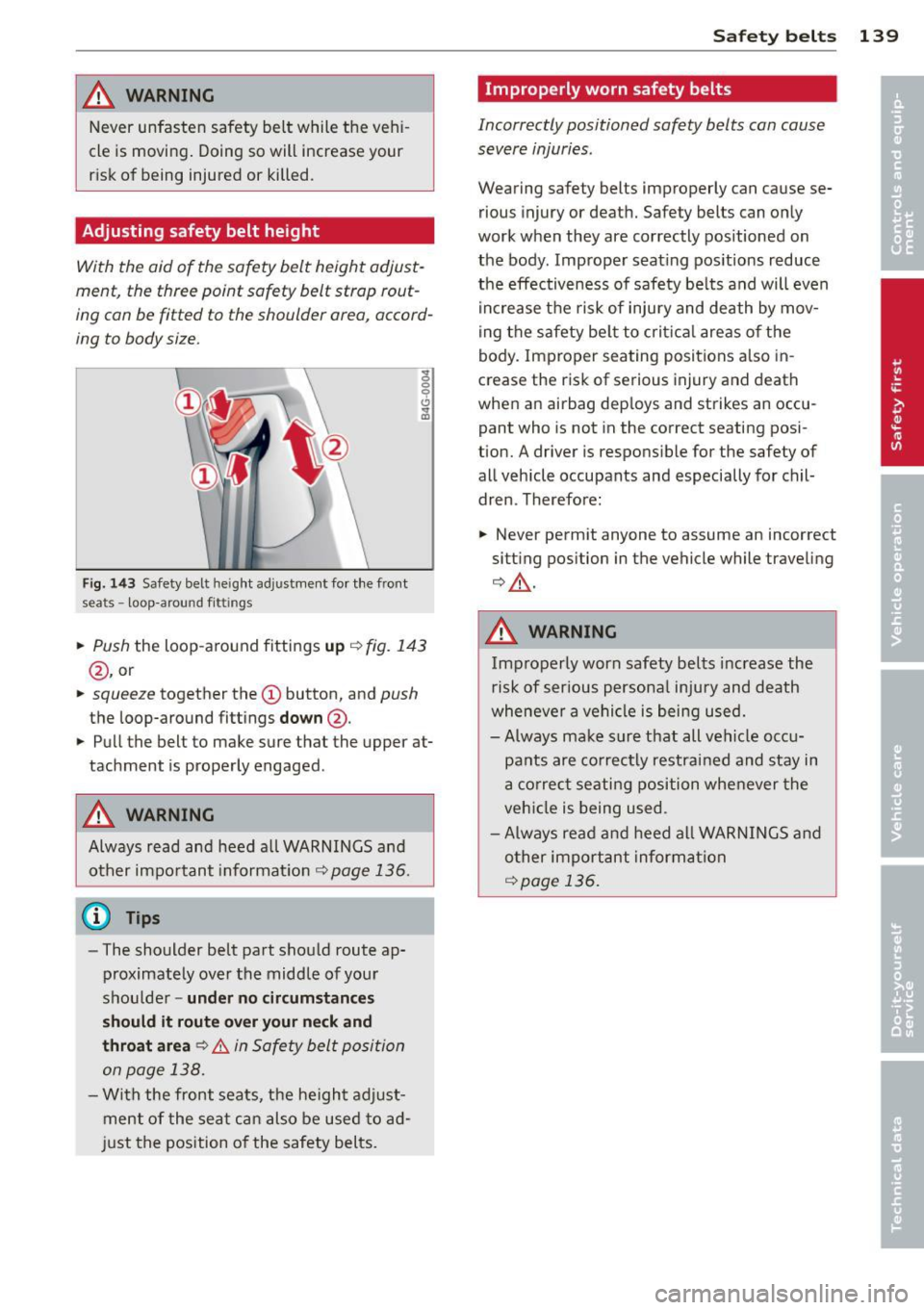
Ji WARNING
Never unfasten safety belt while the vehi
cle is movi ng . Doing so will increase your
risk of being injured or killed .
Adjusting safety belt height
With the aid of the safety belt height adjust
ment, the three point safety belt strap rout
ing can be fitted to the shoulder area, accord
ing to body size.
Fig. 143 Safety belt heig ht ad justment fo r the front
s e ats - loop -a ro un d f ittin gs
g 0 0 0 ... a,
• Push the loop -around fittings up ¢ fig. 143
@ , or
• squee ze together the (D button, and push
the loop-around fitt ings do wn@ .
• Pull the belt to make sure that the upper at
tachment is properly engaged .
_&. WARNING
Always read and heed all WARNINGS and
other important informat ion ¢
page 136.
(D Tips
-The shoulder belt part should route ap
proximately over the middle of your
shoulder -
under no circum stance s
s h ould it rout e over your n eck and
t hroat area
¢ .&. in Safety belt position
on page 138.
- With the front seats, the he ight adjust
ment of the seat can also be used to ad
j u st the position of the safety belts.
Safety belts 139
Improperly worn safety belts
Incorrectly positioned safety belts can cause
severe injuries .
Wearing safety belts improperly can cause se
rious injury or death. Safety belts can only
work when they are correctly positioned on
the body . Improper seat ing pos itions reduce
the effectiveness of safety be lts and will
even
increase the risk of injury and death by mov
ing the safety be lt to crit ical areas o f the
body. Improper seating positions also in
crease the risk of serious injury and death
when an airbag dep loys and strikes an occu
pant who is not in the correct seating posi
tion. A driver is responsible for the safety of
all vehicle occupants and especially for ch il
dren . Therefore:
• Never permit anyone to assume an incorrect
sitt ing position in the vehicle while traveling
¢ _& .
_&. WARNING
Improperly worn safety belts increase the
risk of serious persona l injury and death
whenever a vehicle is being used.
- Always make sure that all vehicle occu
pants are co rrectly restrained and stay in
a co rrec t seating position whenever the
veh icle is being used.
- Always read and heed al l WARNINGS and
other important informat ion
¢ page 136.
Page 142 of 298
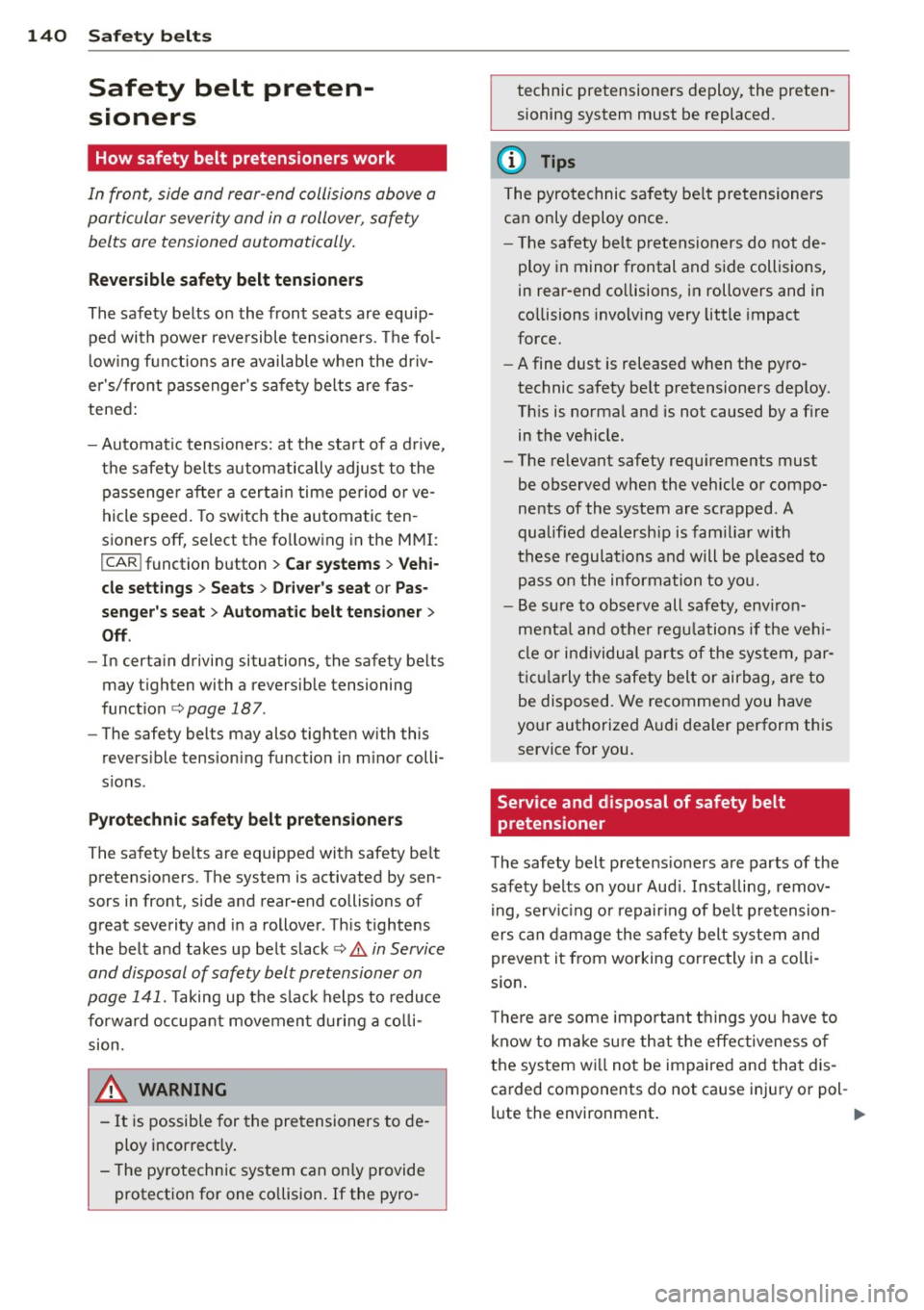
140 Safety belts
Safety belt preten
sioners
How safety belt pretensioners work
In front, side ond rear-end collisions above a
particular severity and in o rollover, safety belts are tensioned automatically.
Reversible safety belt tensioners
The safety belts on the front seats are equip
ped with power reversible tensioners . The fol
lowing functions are available when the driv
er's/front passenger's safety belts are fas
tened:
- Automatic tensioners: at the start of a drive,
the safety belts automatically adjust to the
passenger after a certain time period or ve
hicle speed. To switch the automatic ten
sioners off, select the following in the
MMI:
I CAR ! function button > Car systems > Vehi·
cle settings
> Seats > Driver's seat or Pas·
senger's seat
> Automatic belt tensioner >
Off .
-In certain driving situations, the safety belts
may tighten with a reversible tensioning
function
c:> page 187 .
-The safety belts may also tighten with this
reversible tensioning function in minor colli
sions .
Pyrotechnic safety belt pretensioners
The safety belts are equipped with safety belt
pretensioners . The system is activated by sen
sors in front, side and rear-end collisions of
great severity and in a rollover . This tightens
the belt and takes up belt slack
c:> &. in Service
and disposal of safety belt pre tensioner on
page 141.
Taking up the slack helps to reduce
forward occupant movement during a colli
sion.
& WARNING
- It is possible for the pretensioners to de
ploy incorrectly.
- The pyrotechnic system can only provide
protection for one collision. If the pyro- technic
pretensioners deploy, the preten
sioning system must be replaced.
(D Tips
The pyrotechnic safety belt pretensioners
can only deploy once.
- The safety belt pretensioners do not de
ploy in minor frontal and side collisions,
in rear-end collisions, in rollovers and in
collisions involving very little impact
force.
- A fine dust is released when the pyro
technic safety belt pretensioners deploy.
This is normal and is not caused by a fire
in the vehicle.
- The relevant safety requirements must
be observed when the vehicle or compo
nents of the system are scrapped. A
qualified dealership is familiar with
these regulations and will be pleased to
pass on the information to you.
- Be sure to observe all safety, environ
mental and other regulations if the vehi
cle or individual parts of the system, par
ticularly the safety belt or airbag, are to
be disposed. We recommend you have
your authorized Audi dealer perform this
service for you.
Service and disposal of safety belt
pretensioner
The safety belt pretensioners are parts of the
safety belts on your Audi. Installing, remov
ing, servicing or repairing of belt pretension
ers can damage the safety belt system and
prevent it from working correctly in a colli
sion.
There are some important things you have to
know to make sure that the effectiveness of
the system will not be impaired and that dis
carded components do not cause injury or pol-
lute the environment. .,..
Page 143 of 298
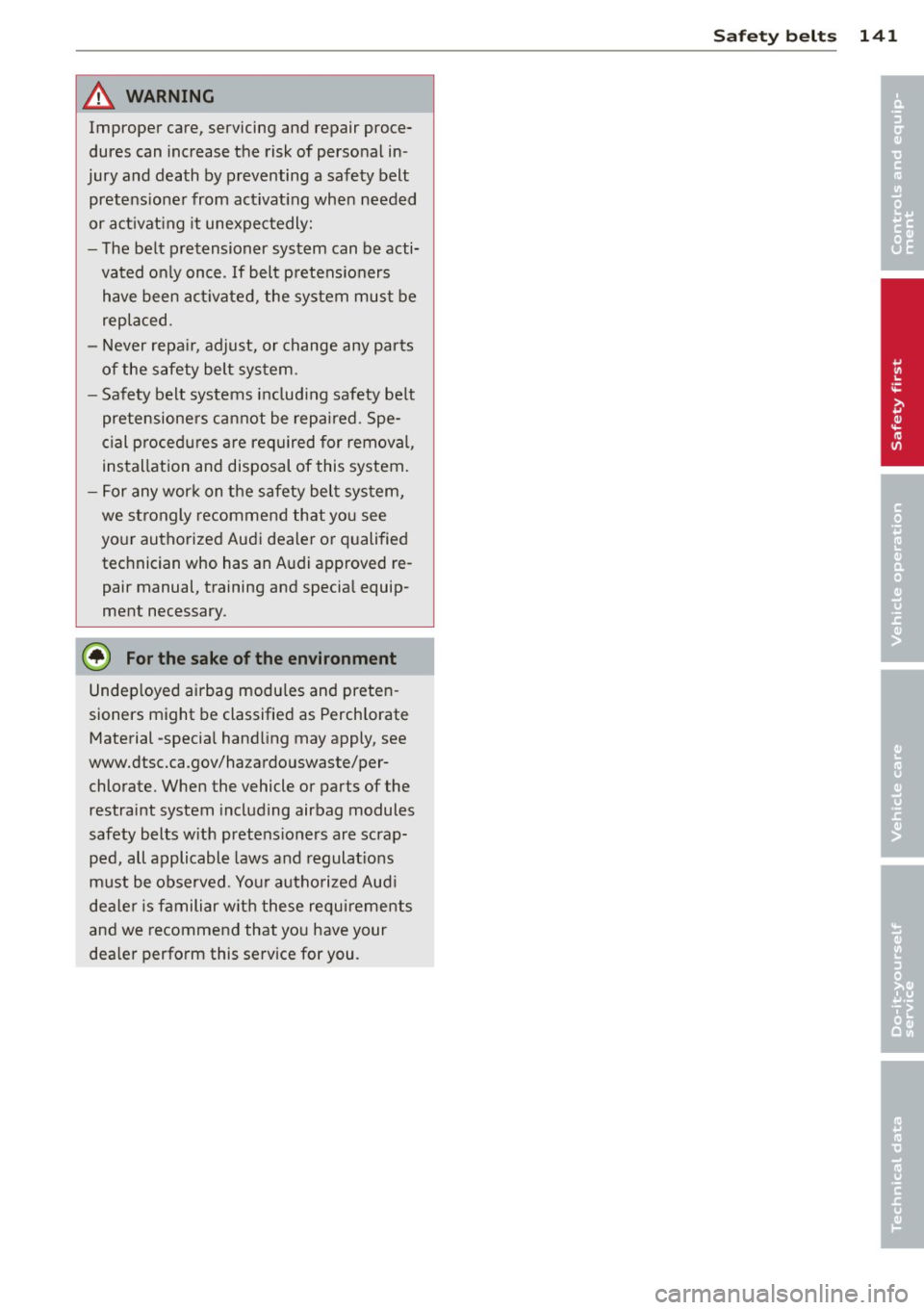
A WARNING ,~
Improper care, servicing and repair proce
dures can increase the risk of personal in
jury and death by preventing a safety belt pretens ione r from act ivat ing when needed
or act ivat ing it unexpe ctedly:
- The be lt pretensioner system can be acti
vated on ly once. If belt p retens ioners
have been act ivated, the system mus t be
replaced.
- Never repa ir, adjust, or change any parts
of the safety belt system.
- Safe ty belt systems includ ing safety be lt
pretensione rs cannot be repaired. Spe
ci al p rocedures are required for removal,
installation and disposal of this system.
- For any wor k on the safety belt sys tem,
we strongly recommend th at you see
yo ur authorized Audi dealer o r qualified
technician who has an A udi approved re
pair manual, training and specia l equip
ment necessary.
@ For the sake of the environment
Undep loyed airbag modu les and preten
sioners might be classified as Perchlorate Material -specia l hand ling may apply, see
www.dtsc.ca.gov/hazardouswaste/per chlorate. When the vehicle or parts of the
restraint system including airbag modules
safety belts w ith pretens ioners are scrap
ped, all applicable laws and regulat ions
must be observed. Your autho rized Aud i
dea le r i s familiar w ith these requirements
and we recommend that you have your
dea ler perform this service for you.
Sa fety belts 141
•
•
Page 144 of 298
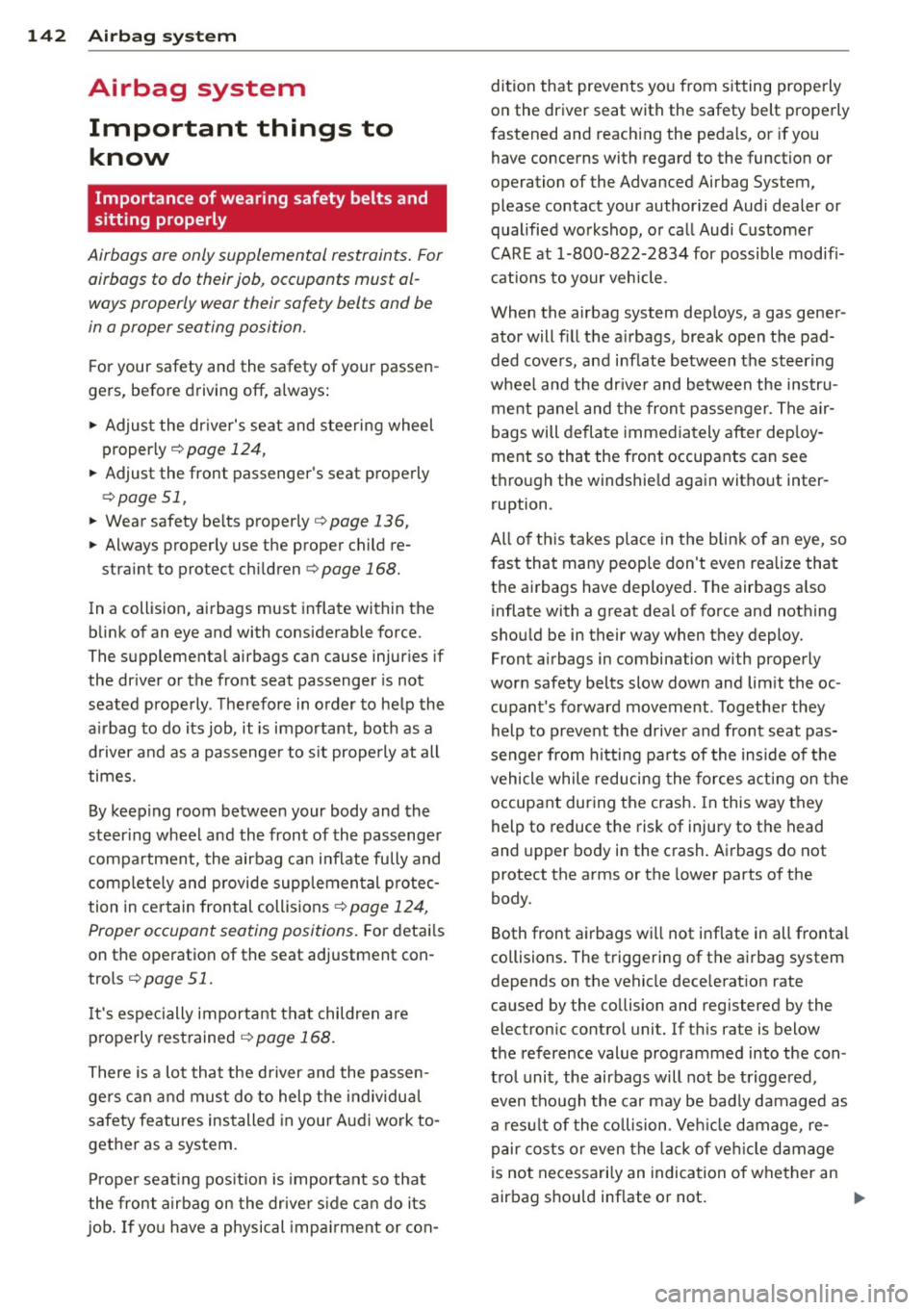
142 Airbag sys te m
Airbag system
Important things to know
Importance of wearing safety belts and
sitting properly
Airbags are only supplemental restraints. For
airbags to do their job , occupants must al
ways properly wear their safety belts and be
in a proper seating position.
F or your safety and the safety of your passen
gers, before driving off, always:
• Adjust the dr iver's seat and steering wheel
properly ¢
page 124,
• Adjust the front passenger's seat properly
r=;page 51,
• Wear safety be lts properly r=; page 136,
• Always properly use the proper child re-
straint to protect children¢
page 168.
In a collision, airbags must inflate within the
blink of an eye and with considerable force .
The supplemental airbags can cause injuries if
the dr iver or the front seat passenger is not
seated properly . Therefore in order to he lp the
a irbag to do its job, it is important, both as a
d river and as a passenger to sit properly at all
times.
By keeping room between your body and the
steering wheel and the front of the passenger
compartment, the airbag can inflate fully and
comp letely and provide supp lemental protec
tion in certain frontal collisions
r=:; page 124,
Proper occupant seating positions.
F or detai ls
on the operat ion of the seat adjustment con
trols ¢
page 51.
It's especially important that children are
properly restrained ¢
page 168.
There is a lot that the driver and the passen
gers can and must do to help the individua l
safety features ins talled in your A udi work to
gether as a system.
Prope r seat ing pos ition is important so that
the front airbag on the driver s ide can do i ts
job. If you have a physical impa irment or con- dition that prevents you from sitting properly
on the driver seat with the safety belt properly
fastened and reaching the peda ls , or if you
have concerns with regard to the function or
operation of the Advanced Airbag System,
please contact your author ized Audi dealer or
qualified workshop, or call Audi Customer
CARE at 1-800-822-2834 for possible modifi
cations to your vehicle .
When the airbag system deploys, a gas gener
ator will f ill the a irbags, break open t he pad
ded cove rs, and inflate between the steer ing
whee l and the dr iver and between the instru
ment pane l and the front passenger. The a ir
bags will deflate immediately after dep loy
ment so that the front occupants can see
t h rough the windshie ld again witho ut inter
ruption .
All of th is takes p lace in the b link of an eye, so
fast that many peop le don't even realize tha t
the airbags have deployed. The airbags a lso
inflate with a great dea l of force and nothing
shou ld be in their way when they deploy.
Front airbags in combination with properly
wor n safety belts slow down and lim it the oc
cupant's forward movement . T ogether they
help to prevent the drive r and front seat pas
senger from hitting pa rts of the inside of the
vehicle while reducing the forces acting on the
occupant dur ing the crash . In this way they
help to reduce the risk of injury to the head
and upper body in the crash. A irbags do not
protect the arms or the lower parts of the
body.
Both front airbags wi ll not inflate in all fronta l
collisions . The t riggering of the airbag system
depends on the vehicle dece lerat ion rate
caused by the co llision and registered by the
electron ic control unit. If th is rate is below
the reference value programmed into the con
t rol unit , the airbags will not be trigge red,
even though the car may be badly damaged as
a res ult of the co llision . Ve hicl e damage, re
pair costs or even the lack of ve hicle damage
is not necessari ly an indication of whether an
airbag shou ld inflate or not .
IJll-
Page 145 of 298
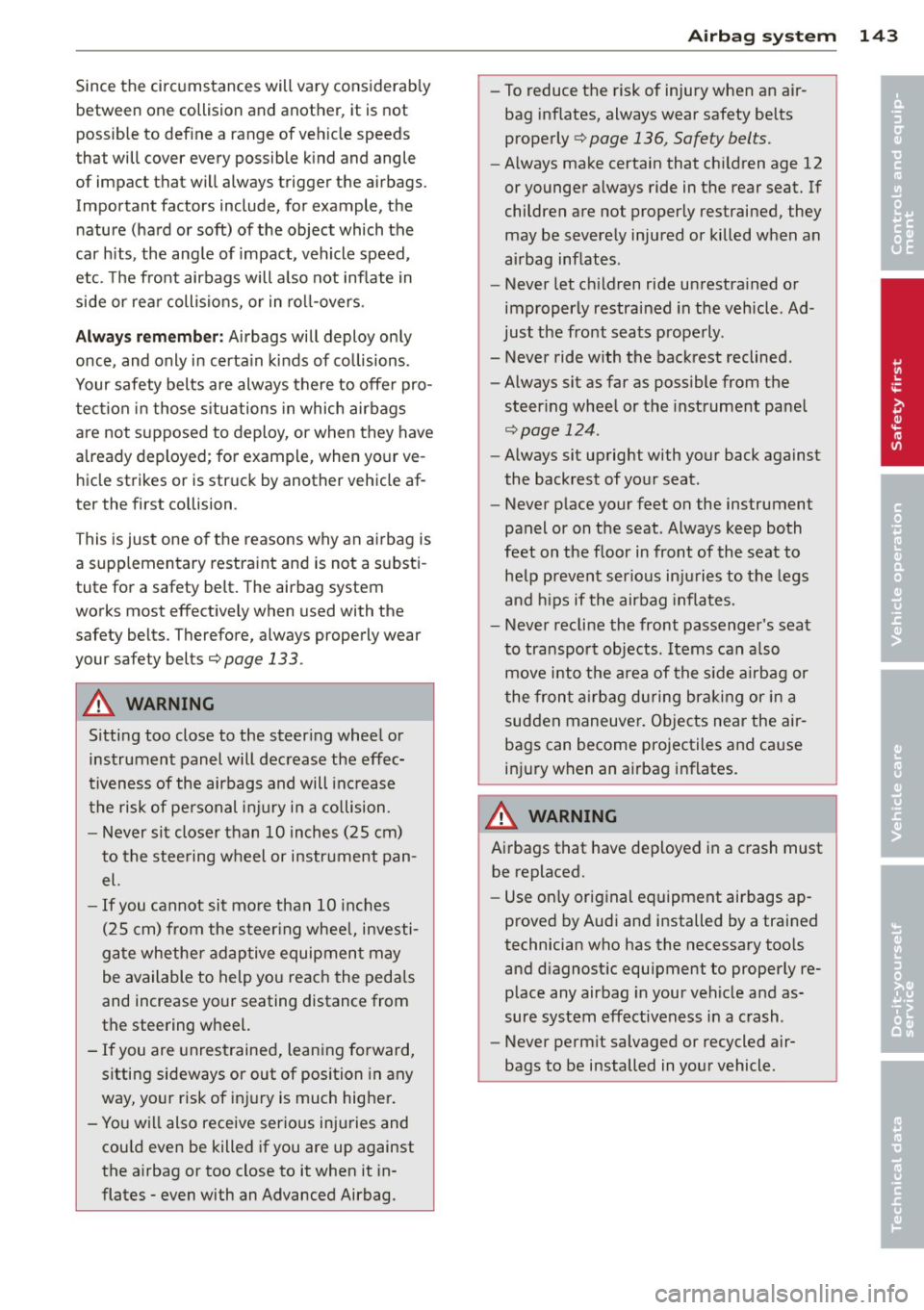
Since the circumstances will vary considerably
between one collision and another , it is not
possible to define a range of veh icle speeds
that will cover every possible k ind and angle
of impact that will always trigger the airbags .
Important factors include, for example, the nature (hard or soft) of the object which the
car h its, the ang le of impact, vehicle speed ,
etc. The front airbags will a lso not inflate in
side or rear collisions, or in ro ll-overs .
Alw ays rememb er: Airbags will deploy only
once, and only in certa in kinds of collisions.
Your safety belts are always there to offe r pro
tect ion in those s ituations in which airbags
are not supposed to deploy , or when they have
a lready deployed ; for example , when your ve
hicle strikes or is struck by another vehicle af
ter the first co llision .
This is just one of the reasons why an a irbag is
a supp lementary restraint and is not a s ubsti
tute for a safety belt . The airbag system
works most effectively when used with the
safety belts. Therefore, always properly wear
your safety belts ¢
page 133.
A WARNING
Sitting too close to the steer ing whee l or
instrument panel will decrease the effec
tiveness of the airbags and will inc rease
the risk of pe rsonal injury in a co llision .
- Never sit closer than 10 inches (2S cm)
to the stee ring wheel or instr ument pan
el.
- If you cannot sit more than 10 inches
( 2 5 cm) from the steer ing whee l, investi
ga te whethe r adaptive equipment may
be available to help you reach the pedals
and increase your seating distance from
the steering wheel.
- If you are unrestrained, lean ing forward,
sitting sideways or out of position in any
way, yo ur risk of inj ury is much higher.
- You w ill also receive serio us injuries and
cou ld even be killed if you are up against
the a irbag or too close to it when it in
flates -even with an Advanced Airbag.
A irbag system 143
-To reduce the risk of injury when an air
bag inflates, always wear safety belts
properly ¢
page 136, Safety belts.
-Always make certain that ch ild ren age 12
or younger a lways ride in the rear seat. If
children are not properly restrained, they may be severe ly injured or killed when an
airbag inf lates .
- Never let ch ildren ride unrestra ined or
improperly restrained in the vehicle. Ad
just the front seats prope rly .
- Never ride with the backrest reclined .
- Always sit as far as possible from the
steer ing whee l or the instrument pane l
¢page 124.
-Always sit upright with your back against
the backrest of your seat .
- Never p lace your feet on the instrument
panel or on the seat. Always keep both
feet on the f loor in front of the seat to
he lp preven t serio us in ju ries to the legs
and h ips if the airbag infla tes.
- Never recline the front passenger 's seat
to transport objects . Items can a lso
move into the area of the s ide a irbag or
the front a irbag du ring bra king or in a
sudden maneuve r. Obje cts near the air
bags can become projectiles and cause
in ju ry when an airbag inflates.
A WARNING
Airbags that have deployed in a crash must
be replaced.
- Use on ly original equipment airbags ap
proved by Aud i and installed by a trained
technician who has the necessary too ls
and d iagnost ic equipment to properly re
place any airbag in your vehicle and as
sure system effectiveness in a crash .
- Never perm it salvaged or recycled air
bags to be installed in your vehicle . •
•
Page 146 of 298
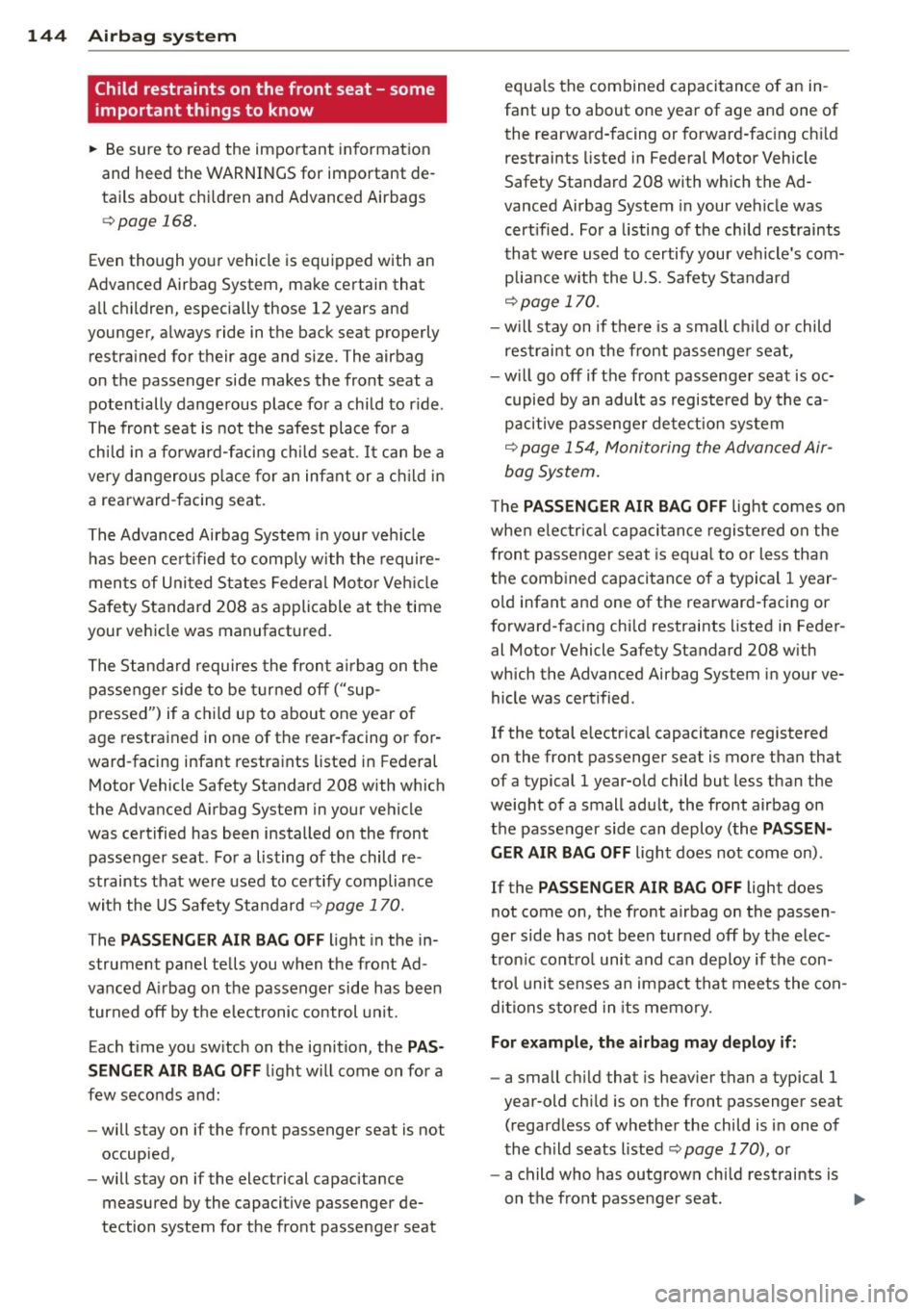
144 Airbag sys tem
Child restraints on the front seat - some
important things to know
• Be sure to read the impo rtant in forma tion
and heed the WARNINGS for important de
ta ils about ch ildren and Advanced Airbags
i=> page 168.
Even though yo ur vehicle is equipped with an
Advanced Airbag System, make certain that
all children, especially those 12 years and
younger, a lways ride in the back seat properly
res tra ined for their age and si ze. The airbag
on the passenger side makes the front seat a potentially dangerous place for a child to r ide .
The front seat is not the safest place fo r a
chi ld in a fo rward-faci ng chi ld sea t.
It can be a
ve ry dangerous p lace for an infant or a c hild in
a rearward -facing seat.
The Advanced Airbag System i n your veh icle
has been certified to comply with the require
men ts of Uni ted States Federa l Mo to r Veh icle
Safety Standard 208 as applicable at the time
your ve hicle was manufact ured.
The Standa rd requires the fron t air bag on t he
passenger side to be turned off ("sup
p ressed") if a c hild up to about one yea r of
age restrained in one of the rear-facing or for
ward-facing infant restra ints listed in Federal
Motor Vehicle Safety Standard 208 with which
the Advanced A irbag System in your vehicle
was certified has been installed on the front passenger seat . For a listing of the child re
straints that we re used to certify compliance
with the US Safety Sta ndard
c> page 170.
The PASSENGER AIR BAG OFF light in the in
strument panel te lls you when the front Ad
vanced A irbag on t he passenger side has been
turned off by t he e lectronic control unit.
Each t ime you sw itch on the ignit ion, the
PAS
SENGER AIR BAG OFF
li ght w ill come on for a
few seconds a nd:
- will stay on if the front passenger seat is not
occupied ,
- will stay on if the electrical capacitance
measured by the capacitive passenger de
tection system fo r the fro nt passenger seat equa
ls the combined capacitance of an in
fant up to about one year of age and one of the rearwa rd- facing or forward-fac ing ch ild
restraints listed in Federal Motor Vehicle
Safety Standard 208 with which the Ad
vanced Airbag System in your vehicle was
cert ified . For a listing of the ch ild restraints
that w ere used to certify you r vehicle 's com
plia nce w it h t he U.S. Safety Standard
i=> page 170 .
-w ill stay on if the re is a small c hild or child
restrai nt on the front passenge r seat,
- w ill go off if the front passenger seat is oc
cupied by an adult as registered by the ca
p acitive passenge r de te ction system
c> page 154, Monitoring the Advanced Air
bag System.
T he PASSENGER AIR BAG OFF light comes on
whe n elec trica l capacitance regis tered on the
front passenger seat is eq ua l to or less than
t h e comb ined ca pacitance of a typical 1 year
o ld infant and one of the rearward-facing or
forward-facing chi ld restraints listed in Feder
al Motor Vehicle Safety Standard 208 with
which the Advanced Airbag System i n your ve
hicle was cert ified .
If the total e lectr ica l capacitance registered
on the front passenger seat is more than that
of a typical 1 year-o ld child but less than the
we ight of a small adu lt, the front airbag on
the passenger side can deploy (the
PASSEN
GER AIR BAG OFF
light does not come on) .
If the
PASSENGER AIR BAG OFF ligh t does
not come on , the front airbag on the passen
ger side has not been turned off by the e lec
t ron ic cont ro l unit and can deploy if th e con
t ro l u nit se nses an impa ct that mee ts the con
di tions s to red in its memory.
For example, the airbag may deploy if:
- a small ch ild that is heav ier t han a typical 1
year-old ch ild is on the front passenger seat
(regard less of whethe r the child is in one of
the ch ild seats listed
c::;, page 170), o r
- a child who has outgrown ch ild restraints is
on the front passenger seat . ..,.
Page 147 of 298
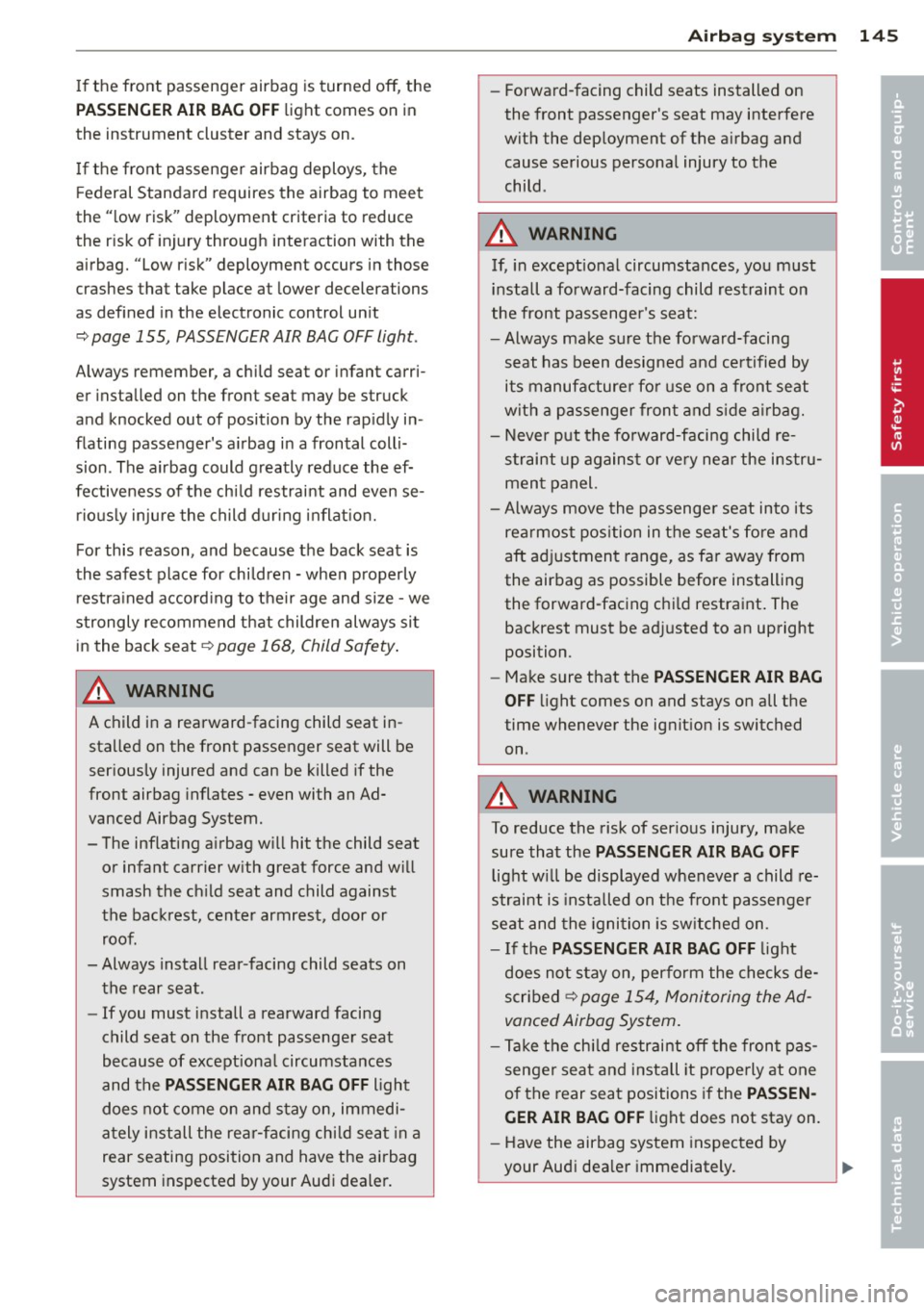
If the fron t passenger airbag is turned off, the
PA SSENGER AIR BA G OF F light comes on in
the instrument cluster and stays on.
If the front passenger airbag deploys, the
F ederal Standard requires the airbag to meet
the " low risk" deployment criteria to reduce
the r isk of injury through interaction with the
airbag. "Low risk" deployment occurs in those
crashes that take place at lower decelerations
as defined in the electronic control un it
c::> page 155, PASSENGER AIR BAG OFF light.
Always remember, a child seat or infant carri
er installed on the front seat may be struck
and knocked out of position by the rap idly in
flating passenger's a irbag i n a frontal colli
sion . The airbag could greatly reduce the ef
fectiveness of t he ch ild restraint and even se
r io usly inju re the child d uring inflat io n.
For this reason, and because the back seat is
the safest place for chi ldren - when properly
restra ined accord ing to their age and size - we
strongly recommend that children always sit in the back seat
c::> page 168, Child Safety .
A WARNING
-
A child in a rearward-facing child seat in
stalled on the front passenger seat will be
ser iously injured and can be killed if the
front airbag inflates - even with an Ad
vanced Airbag System.
- The inflating airbag w ill hit the child seat
or infant carrier w ith great force and w ill
smash the ch ild seat and child against
the backrest, center armrest, door or roof.
- Always install rear-facing child seats on
the rear seat.
- If you must install a rearward facing
child seat on the front passenge r seat
because of exceptiona l circumstances
and the
PASSENGER AIR BAG OFF light
does no t come on an d stay on, immedi
at ely install the rear-facing chi ld seat in a
rear seating position and have the airbag
system inspected by your Audi dealer.
A irbag system 145
-Forwa rd-facing child seats installed on
the front passenger's seat may interfere
with the dep loyment of the airbag and
cause serious persona l injury to the
child.
A WARNING
If, in except ional circumstances, you must
install a forward-facing child restraint on
the front passenge r's seat:
- Always make sure the forward-facing
seat has been designed and certified by its manufacture r for use on a front seat
wit h a passenger fron t and s ide a irbag.
- Never put the fo rward-facing child re
s tra int up agains t or ve ry near the instru
men t panel.
- Always move the passenge r seat into its
rea rmost pos ition in the se at's fore and
aft ad justment range, as fa r away from
the airbag as possible before installing
the forward-fac ing ch ild restra int . The
backrest must be adj usted to an upright
position.
- Make sure that the
PASSENGER AIR BAG
OFF
li ght comes on and stays on all the
time whenever the ignition is switched on .
A WARNING
To reduce the risk of ser ious injury, make
sure that the
PASSENGER AIR BAG OFF
light w ill be displayed whenev er a child re
straint is insta lled on the fro nt passenge r
se at and the ignition is sw itched on.
- If the
PASSENGER AIR BAG OFF light
does not s tay on, perform the checks de
scribed
c::> page 154, Monitoring the Ad
vanced Airbag System.
- T ake the chi ld restraint off t he fron t pas
senger sea t and install it prope rly at one
of the rear seat positions i f the
PASS EN·
GER AIR BAG OFF
light does not stay on.
- Have the airbag system inspected by
your Aud i dea ler immediately.
•
•
Page 148 of 298
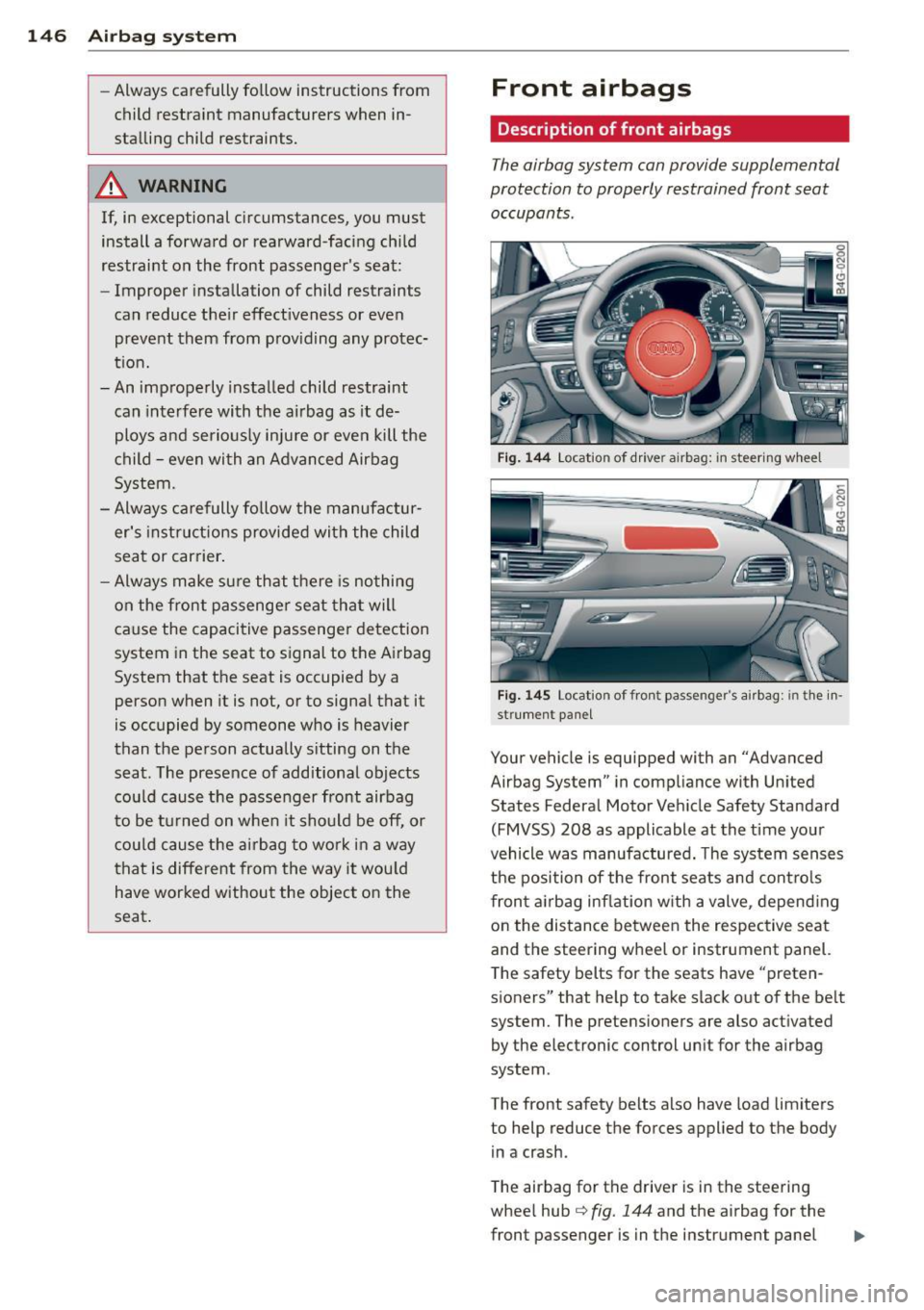
146 Airbag system
-Always carefully follow instructions from
child restraint manufacturers when in
stalling child restraints.
_& WARNING
If, in exceptional circumstances, you must
install a forward or rearward -facing child
restraint on the front passenger's seat:
- Improper installation of child restraints
can reduce their effectiveness or even
prevent them from providing any protec
tion.
- An improperly installed child restraint
can interfere with the airbag as it de
ploys and seriously injure or even kill the
child -even with an Advanced Airbag
System.
- Always carefully follow the manufactur
er's instructions provided with the child
seat or carrier .
- Always make sure that there is nothing
on the front passenger seat that will
cause the capacitive passenger detection
system in the seat to signal to the Airbag
System that the seat is occupied by a person when it is not, or to signal that it
is occupied by someone who is heavier
than the person actually sitting on the
seat . The presence of additional objects
could cause the passenger front airbag
to be turned on when it should be off, or
could cause the airbag to work in a way
that is different from the way it wou ld
have worked without the object on the
seat.
Front airbags
Description of front airbags
The airbag system can provide supplemental
protection to properly restrained front seat occupants .
Fig. 144 Locatio n of drive r ai rbag: in steering wh eel
Fig. 145 Locat io n of fron t passenger' s air bag: in the in·
st rument panel
Your vehicle is equipped with an "Advanced
Airbag System" in compliance with United
States Federal Motor Vehicle Safety Standard
(FMVSS) 208 as applicable at the time your
vehicle was manufactured. The system senses
the position of the front seats and controls
front airbag inflation with a valve , depending
on the distance between the respective seat
and the steering wheel or instrument panel.
The safety belts for the seats have "preten
sioners" that help to take slack out of the belt
system. The pretensioners are also activated by the electronic control uni t for the airbag
system .
The front safety belts also have load limiters
to help reduce the forces applied to the body in a crash.
The airbag for the driver is in the steering
wheel hub
¢ fig. 144 and the airbag for the
front passenger is in the instrument panel
Page 149 of 298
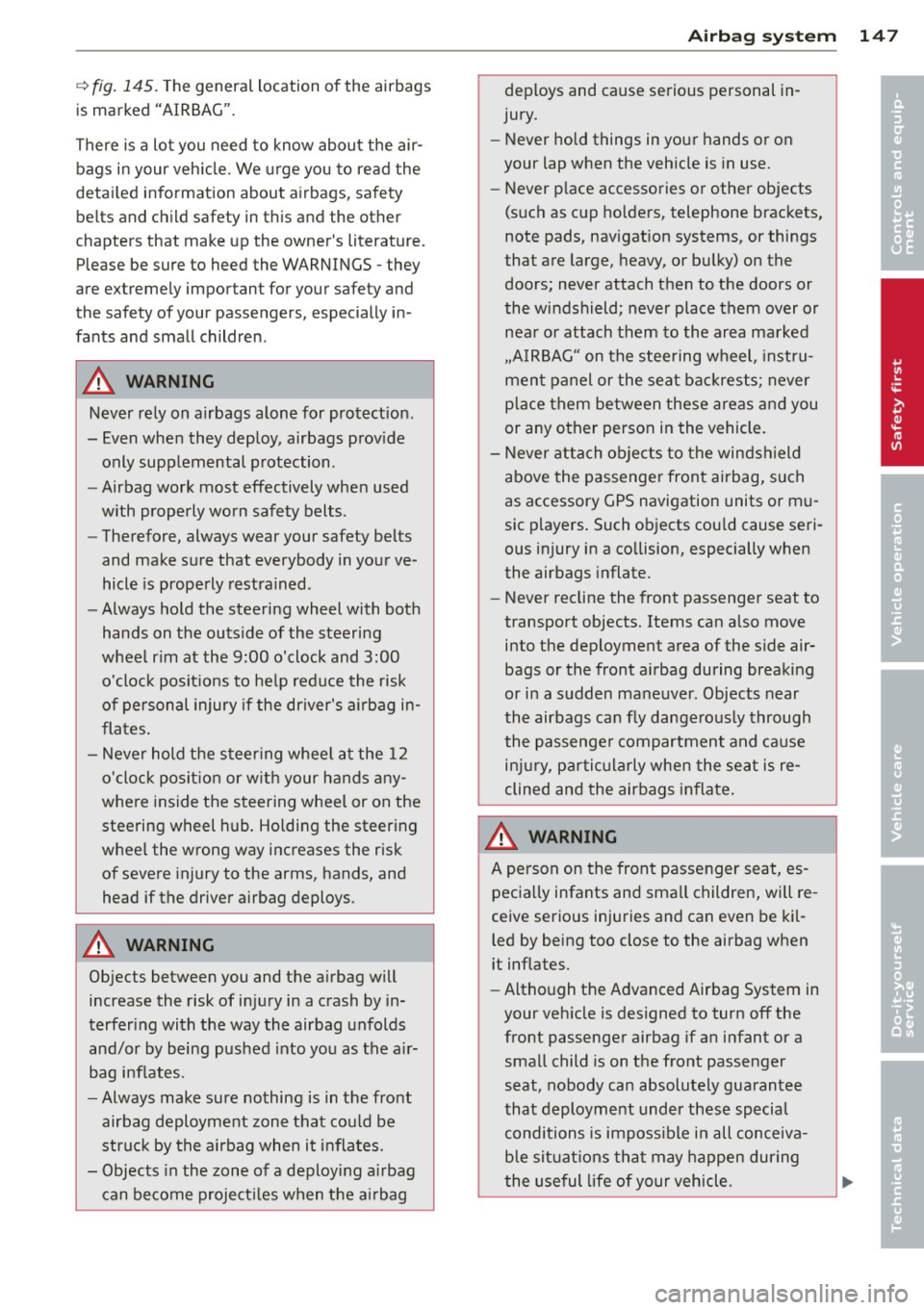
q fig. 145. The general location of the airbags
is marked "AIRBAG".
There is a lot you need to know about the air bags in your vehicle. We urge you to read the
detailed information about airbags, safety
belts and child safety in this and the other
chapters that make up the owner's literature.
Please be sure to heed the WARNINGS -they
are extremely important for your safety and
the safety of your passengers, especially in
fants and small children .
A WARNING
Never rely on airbags alone for protection.
- Even when they deploy, airbags provide only supplemental protection .
- Airbag work most effectively when used
with properly worn safety belts .
- Therefore, always wear your safety belts
and make sure that everybody in your ve
hicle is properly restrained .
- Always hold the steering wheel with both
hands on the outside of the steering
wheel rim at the 9:00 o'clock and 3:00 o'clock positions to help reduce the risk
of personal injury if the driver's airbag in
flates.
- Never hold the steering wheel at the 12
o'clock position or with your hands any
where inside the steering wheel or on the
steering wheel hub. Holding the steering
wheel the wrong way increases the risk
of severe injury to the arms, hands, and
head if the driver airbag deploys .
A WARNING
Objects between you and the airbag will
increase the risk of injury in a crash by in
terfering with the way the airbag unfolds
and/or by being pushed into you as the air
bag inflates.
- Always make sure nothing is in the front
airbag deployment zone that could be
struck by the airbag when it inflates.
- Objects in the zone of a deploying airbag
can become projectiles when the airbag
Airbag system 147
deploys and cause serious personal in
Jury.
- Never hold things in your hands or on
your lap when the vehicle is in use.
- Never place accessories or other objects
(such as cup holders, telephone brackets,
note pads, navigation systems, or things
that are large, heavy, or bulky) on the
doors; never attach then to the doors or
the windshield; never place them over or
near or attach them to the area marked
,,AIRBAG" on the steering wheel, instru
ment panel or the seat backrests; never
place them between these areas and you
or any other person in the vehicle.
- Never attach objects to the windshield
above the passenger front airbag, such
as accessory GPS navigation units or mu
sic players. Such objects could cause seri
ous injury in a collision, especially when
the airbags inflate.
- Never recline the front passenger seat to
transport objects. Items can also move
into the deployment area of the side air
bags or the front airbag during breaking
or in a sudden maneuver. Objects near
the airbags can fly dangerously through
the passenger compartment and cause injury, particularly when the seat is re
clined and the airbags inflate.
WARNING
A person on the front passenger seat, es
pecially infants and small children, will re
ceive serious injuries and can even be kil
led by being too close to the airbag when
it inflates.
- Although the Advanced Airbag System in
your vehicle is designed to turn off the
front passenger airbag if an infant or a
small child is on the front passenger
seat, nobody can absolutely guarantee
that deployment under these special conditions is impossible in all conceiva
ble situations that may happen during
the useful life of your vehicle . .,.
•
•
Page 150 of 298
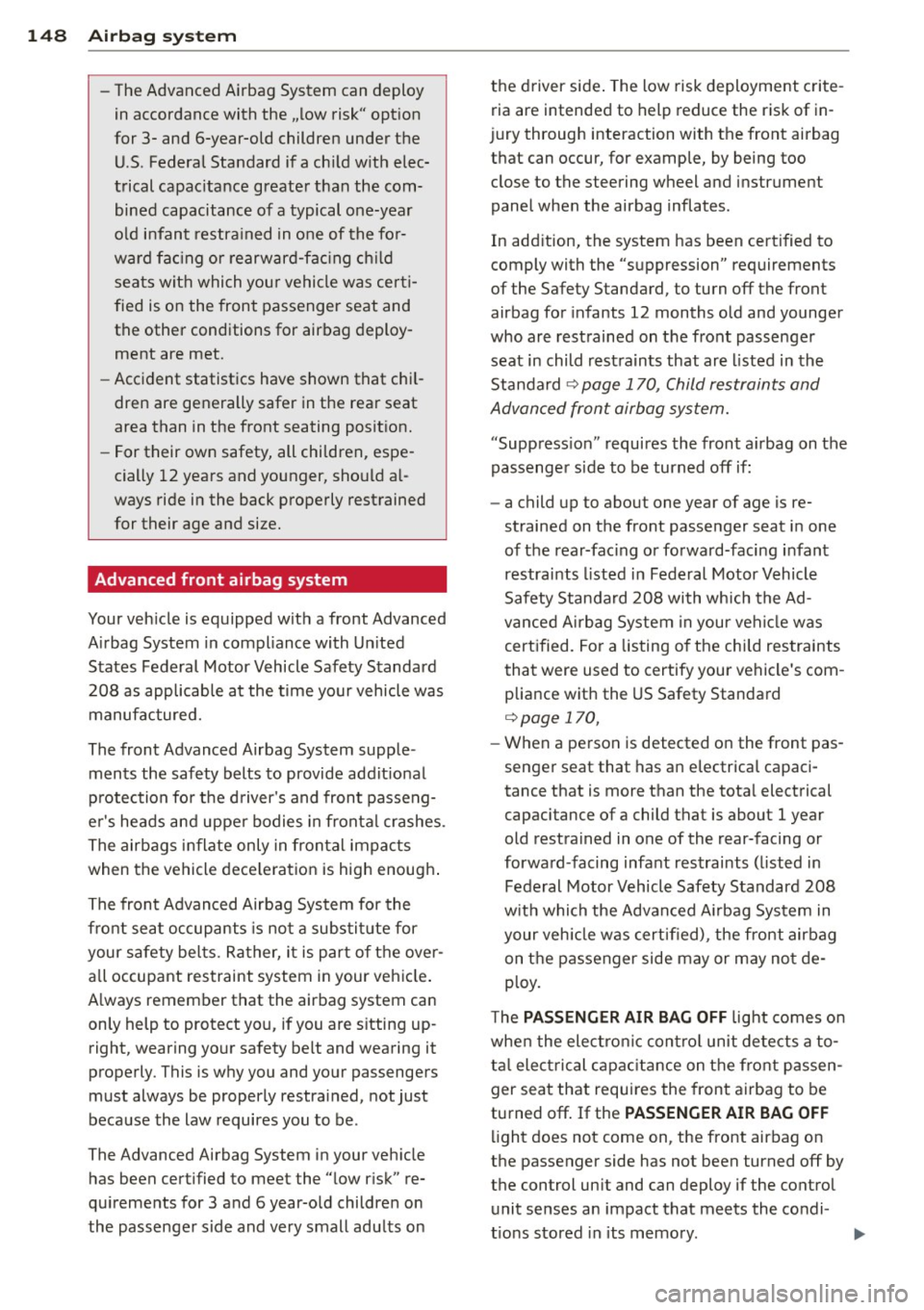
148 Airbag system
-The Advanced Airbag System can deploy
in accordance with the .,low risk" option
for 3- and 6-year-old children under the U.S . Federal Standard if a child with elec
trical capacitance greater than the com bined capacitance of a typical one-year
old infant restrained in one of the for
ward facing or rearward-facing child
seats with which your vehicle was certi
fied is on the front passenger seat and
the other conditions for airbag deploy ment are met.
- Accident statistics have shown that chil
dren are generally safer in the rear seat
area than in the front seating position.
- For their own safety, all children, espe
cially 12 years and younger, should al
ways ride in the back properly restrained
for their age and size.
Advanced front airbag system
Your vehicle is equipped with a front Advanced
Airbag System in compliance with United
States Federal Motor Vehicle Safety Standard
208 as applicable at the time your vehicle was manufactured.
The front Advanced Airbag System supple
ments the safety belts to provide additional
protection for the driver's and front passeng
er's heads and upper bodies in frontal crashes .
The airbags inflate only in frontal impacts
when the vehicle deceleration is high enough.
The front Advanced Airbag System for the
front seat occupants is not a substitute for
your safety belts. Rather, it is part of the over all occupant restraint system in your vehicle.
Always remember that the airbag system can
only help to protect you, if you are sitting up
right, wearing your safety belt and wearing it
properly . This is why you and your passengers
must always be properly restrained, not just
because the law requires you to be.
The Advanced Airbag System in your vehicle has been certified to meet the "low risk" re
quirements for 3 and 6 year-old children on
the passenger side and very small adults on the driver side. The low risk deployment crite
ria are intended to help reduce the risk of in
jury through interaction with the front airbag
that can occur, for example, by being too close to the steering wheel and instrument
panel when the airbag inflates.
In addition, the system has been certified to
comply with the "suppression" requirements
of the Safety Standard, to turn off the front
airbag for infants 12 months old and younger
who are restrained on the front passenger
seat in child restraints that are listed in the
Standard
c::> page 170, Child restraints and
Advanced front airbag system.
"Suppression" requires the front airbag on the
passenger side to be turned off if:
- a child up to about one year of age is re
strained on the front passenger seat in one
of the rear-facing or forward-facing infant
restraints listed in Federal Motor Vehicle
Safety Standard 208 with which the Ad
vanced Airbag System in your vehicle was
certified. For a listing of the child restraints
that were used to certify your vehicle's com
pliance with the US Safety Standard
i=>page 170,
-When a person is detected on the front pas
senger seat that has an electrical capaci
tance that is more than the total electrical
capacitance of a child that is about 1 year
old restrained in one of the rear-facing or
forward -facing infant restraints (listed in
Federal Motor Vehicle Safety Standard 208
with which the Advanced Airbag System in
your vehicle was certified) , the front airbag
on the passenger side may or may not de
ploy.
The
PASSENGER AIR BAG OFF light comes on
when the electronic control unit detects a to
tal electrical capacitance on the front passen ger seat that requires the front airbag to be
turned off. If the
PASSENGER AIR BAG OFF
light does not come on, the front airbag on
the passenger side has not been turned off by
the control unit and can deploy if the control unit senses an impact that meets the condi -
tions stored in its memory. ..,_